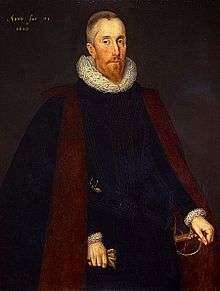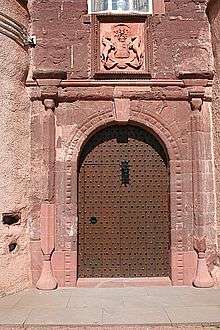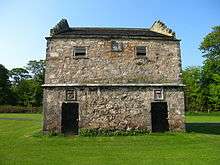Alexander Seton, 1st Earl of Dunfermline

Alexander Seton, 1st Earl of Dunfermline (1555–1622) was a Scottish lawyer, judge and politician. He served as Lord President of the Court of Session from 1598 to 1604, Lord Chancellor of Scotland from 1604 to 1622 and as a Lord High Commissioner to the Parliament of Scotland.
Career

Born at Seton Palace, East Lothian, Alexander was the son of George Seton, 7th Lord Seton and Isobell Hamilton. The Setons remained a Roman Catholic family after the Scottish Reformation of 1560, and continued to support Mary, Queen of Scots after her abdication and exile in England. Alexander was educated at the German and Roman College in Rome from June 1571 to December 1578.[1] Alexander was noted learning Italian and science (philosophy) in Rome by Baptista da Trento in 1577 in a letter describing plots to marry Elizabeth I of England to the Earl of Leicester and re-instate Mary in Scotland.[2] The family historian Viscount Kingston heard it said that he was skilled in mathematics, heraldry and architecture, and Alexander might have been made a Cardinal if he had stayed at Rome.[3]
In 1583, Alexander joined his father's embassy to France. William Schaw, the Master of Work to the Crown of Scotland was his companion. They left from Leith in Andrew Lamb's ship.[4] According to the Jesuit Robert Parsons, Lord Seton even considered sending the youthful Alexander back to Scotland as his representative at one point.[5]
Alexander became a Privy Councillor in 1585 and was appointed a Lord of Session as Lord Urquhart in 1586. He rose to be Lord President of the Court of Session and was created Lord Fyvie on 4 March 1598.[6] Anne of Denmark in her capacity as "Lady of Dunfermline" made him 'bailie and justiciary of the regality of Dunfermline on both sides of Forth on 15 February 1596.[7]
At the end of August 1596 according to James Melville, the King arranged a Convention of the Estates at Falkland Palace which included the allies of the forfeited earls. Alexander Seton made a speech like those of Coriolanus or Themistocles calling for the re-instatement of these earls to strengthen the country. The reference to Themistocles, who spoke about naval power to the Athenians, perhaps refers to the forfeited Lord High Admiral of Scotland, Francis Stewart, 5th Earl of Bothwell.[8]
On 7 November 1598 he was made burgess, Guild-brother and Provost of Edinburgh. In March 1598 he took delivery of Spanish and Bordeaux wine, probably for the banquet for Ulrik, the younger brother of Anne of Denmark at Riddle's Court. Other notes in the town's records include a dozen torches supplied by a waxmaker for the baptism of Princess Margaret in April 1599, and another dozen for the baptism of Prince Charles.[9]
His was regarded as one of the finest legal minds of the time, and he became an advisor to James VI and guardian and tutor to Prince Charles, then called the Duke of Albany. After the Union of the Crowns, Seton remained on the committee supervising Anne's Scottish incomes, while James VI went to England, and the infant Charles remained with Seton at Dunfermline Palace.[10] On 14 March 1604 Seton wrote to Robert Cecil on the subject of the union and opinion in Scotland;
This Union is the most at this time of all men's hearts and speeches. I find none of any account here but glad in heart to embrace the same in general: some suspect the particular conditions may engender greater difficulties. I hope the wisdom of the Prince who is both the ground and the cornerstone of this happy Union, with your and other wise men's assistance shall set by all such difficulties: as also I think there can be no particular condition desired for the weal (commonwealth) of one of the nations, but it must be profitable to the other, nor nothing prejudicial to one, but must be hurtful to the other, albeit only by the distracting of their due concord which wise men will think of greater consequence, nor any particular may be subtly cozened (brought) in. This is all I can write even of our thoughts here-away: I doubt not there are divers apprehensions there also."[11]
In 1604 he was appointed Lord Chancellor of Scotland and was created Earl of Dunfermline in 1605. Alexander Seton brought Prince Charles, Duke of Albany, to England in August 1604.[12] He stayed in London till January 1605 in London, co-inciding with the visit of the Ulrik, Duke of Holstein, and had a tour of armouries of the Tower of London. While he was at Whitehall, Viscount Cranborne arranged for him to read the original Treaty of Greenwich, which had led to the war of the Rough Wooing in 1543, and other documents, which he returned to Cecil on 3 November.[13]
Alexander returned to Scotland with more funding to reward his keeping of Prince Charles, made Duke of York on Twelfth Night, and his expenses for his 'pains in the Union' amounting to £200 a year.[14] In 1616 he was required by the Privy Council of Scotland to declare what remained of the Scottish Royal tapestry collection at Dunfermline Palace. He stated there were 10 pieces "of auld and worne tapestrie of the storie of Aeneas, the storie of Troy, and of the story of Mankynd."[15]
His modern humanist and neo-stoic attitude was demonstrated by his energetic defence of Geillis Johnstone accused of witchcraft in 1614.[16]
Artistic and literary patronage

A portrait of his wife Margaret Hay, painted by Marcus Gheeraerts the Younger in 1615 is in the Dunedin Public Art Gallery. Part of a painted ceiling bearing his monogram and heraldry is displayed at Edinburgh's Huntly House museum: his painted long gallery is still preserved at Pinkie House, now Loretto School. Of Pinkie House the family historian wrote, "he built ane noble house, brave stone dykes about the garden and orchards, with other commendable policie about it."[17] Archaeologists have discovered parts of his garden at Fyvie.[18]
His will referred to tapestry of "portrait and forest work" and gilt leather hangings and curtains, almost as valuable as his library at Fyvie and Pinkie.[19] A catalogue of part of his library survives.[20]
In 1599 Robert Pont, the father of the cartographer Timothy Pont dedicated his book, A Newe Treatise of the Right Reckoning of Yeares and Ages of the World, to Alexander Seton. The dedication addressed Seton as "amongst the rare Maecenases of this Land." In 1617, John Napier of Merchiston dedicated his Rabdologiae seu Numerationis per virgulas libri duo to Seton. The book describes the method of multiplication using the rods called "Napier's bones," and its Latin dedication acknowledges the help of Seton as the "illustrious Scottish Maecenas."[21]
Alexander Seton also commissioned the tomb of his friend the architect William Schaw at Dunfermline Abbey.[22]
Death and funeral
After 15 days of illness, Alexander died on Sunday 16 June 1622 at Pinkie. On the 19 June his body was taken by boat across the Forth to his house at Dalgety Bay near Dunfermline. He was buried in his vault in Dalgety Church, on 9 July 1622. A manuscript describes in detail the elaborate procession from the house (long demolished) to the kirk, which included his Master Stabler riding in full armour, and his Master Household with a black flag painted with a skull and tears. John Spottiswoode, Archbishop of St Andrews gave the sermon.[23]
Marriages and children
Alexander Seton first married Lilias Drummond, daughter of Patrick Drummond, 3rd Lord Drummond, their children were;
- Anne Seton, (b. circa 1593), married Alexander Erskine, Viscount Fentoun, their eldest son was Alexander Erskine, 3rd Earl of Kellie.
- Isobel Seton, married John Maitland, 1st Earl of Lauderdale.
- Margaret Seton (I), (b. 1596), died in infancy,
- Margaret Seton (II), (b. 1599), married Colin Mackenzie, 1st Earl of Seaforth.
- Sophia Seton, married David Lindsay, 1st Lord Lindsay of Balcarres.
Alexander Seton married secondly in 1601, Grizel Leslie, a daughter of James Leslie, Master of Rothes, their children were;
- Charles (I), died young.
- Lilias Seton, (b. 1602)
- Jean Seton, (b. circa 1606), married John Hay, 8th Lord Yester.
Alexander Seton married thirdly, circa 1607, Margaret Hay, daughter of John Hay, 7th Lord Yester.
- Charles Seton, 2nd Earl of Dunfermline.
- Grizel Seton, (b. 1609)
- Mary Seton, (b. 1611)
Seton's widow Margaret Hay married James Livingstone, Lord Almond and Earl of Callendar, in 1633.[24]
References
- ↑ Dilworth, Mark,Innes Review, 'Scottish Students at Collegium Germanicum', vol. 19, no. 1 (1968), 20.
- ↑ Historical Manuscripts Commission, Salisbury Manuscripts, Hatfield, vol. 2 (1888), v-vi, 168, Baptista di Trento to Elizabeth.
- ↑ The history of the house of Seytoun to the year 1559, (1829), p. 63
- ↑ Calendar State Papers Scotland, vol.6 (1910), 645, 649
- ↑ Calendar State Papers Scotland, vol. 7 (1913), 235.
- ↑ Maurice Lee jnr, 'King Jame's Popish Chancellor', in Cowan & Shaw ed., Renaissance and Reformation in Scotland, Scottish Academic Press (1983), 170-182.
- ↑ G. Seton,Memoir of Alexander Seton, (Blackwood, Edinburgh 1882), p. 102
- ↑ Mr James Melvill's Diary, (Bannatyne Club, 1829), pp.243-4
- ↑ G. Seton,Memoir of Alexander Seton, (Blackwood, Edinburgh 1882), p. 84, 86-7
- ↑ Register of the Privy Seal of Scotland, vol. 6 (Edinburgh 1884), p.556-7
- ↑ Calendar of the Cecil Papers in Hatfield House, 1604, vol. 16, (1933), under date
- ↑ Seton, Walter W., 'The Early Years of Henry Frederick, Prince of Wales, and Charles, Duke of Albany, 1593-1605', Scottish Historical Review, vol. 13, no. 52 (Jul., 1916), pp. 366-379.
- ↑ G. Seton,Memoir of Alexander Seton, (Blackwood, Edinburgh 1882), pp. 64-5: Calendar of the Cecil Papers in Hatfield House, 1604, vol. 16, (1933), see 3 Nov. 1604</
- ↑ Sawyer, Edmund, ed., Memorials of the affairs of State under Queen Elizabeth and James I, vol.2 (1725), p.46, Chamberlain to Winwood, 26 January 1605
- ↑ Register of the Privy Council of Scotland, 1613-1616, vol. 10 (1891), p. 521
- ↑ David Allan, Philosophy and Politics in Later Stuart Scotland, Tuckwell (2000), 114.
- ↑ Kingston's Continuation of Maitland's House of Seytoun, p.64
- ↑ Shannon Fraser, receive guests with kindness’: Symbols of Hospitality, Nobility and Diplomacy in Alexander Seton's Designed Landscape at Fyvie Castle', Architectural Heritage, vol. 26 Issue 1, (2016), 121-140.
- ↑ George Seton, Memoir of Alexander Seton, William Blackwood (1882),160
- ↑ Ian Campbell, ‘Inventair of som of the Earill of Dunfermline his buiks in Pinkie June 1625’: a fragment of the library of Alexander Seton', Innes Review, 67.1 (2016), pp.31.54.
- ↑ Seton, George, Memoir of Alexander Seton, William Blackwood (1882), pp. 38-40, 121-123, (Vir Illustrissime, ... tanto Maecenate indigni.): The dedication was reprinted in the Peter Rammasen Leiden editions.
- ↑ Church Mounments Society Feb. 2011
- ↑ The Scottish Antiquary, or, Northern Notes and Queries, vol.13, no.52 (April 1899), pp.160-168.
- ↑ Seton, George, Memoir of Alexander Seton, William Blackwood (1882), pp. 150-4
Further reading
- The history of the house of Seytoun to the year 1559, with the continuation by Alex. Viscount Kinston, to 1687, (Glasgow 1829)
- G. Seton, Memoir of Aleander Seton Earl of Dunfermline, (Blackwood, Edinburgh, 1882)
| Legal offices | ||
|---|---|---|
| Preceded by William Baillie of Provand |
Lord President of the Court of Session 1593–1604 |
Succeeded by James Elphinstone, Lord Balmerino |
| Political offices | ||
| Preceded by 3rd Earl of Montrose |
Lord Chancellor of Scotland 1604–1622 |
Succeeded by 1st Earl of Kinnoull |
| Peerage of Scotland | ||
| Preceded by New Creation |
Earl of Dunfermline 1605–1622 |
Succeeded by Charles Seton |